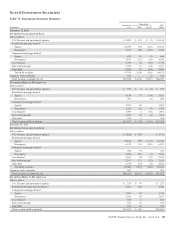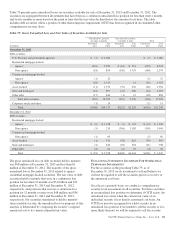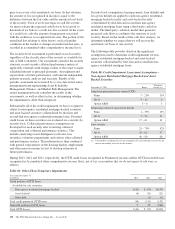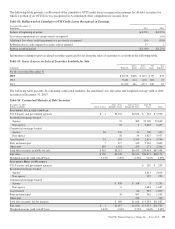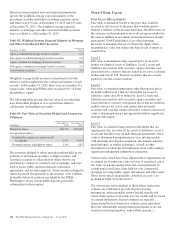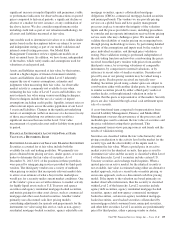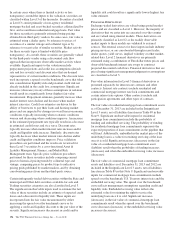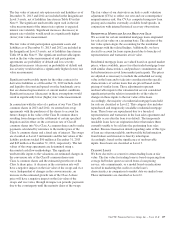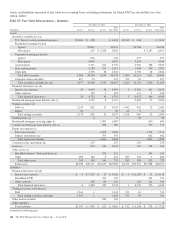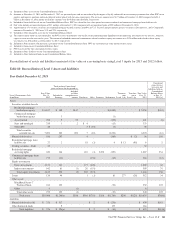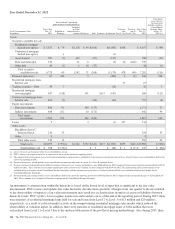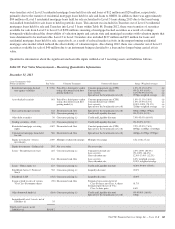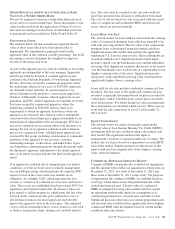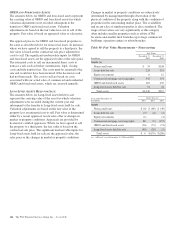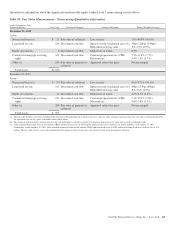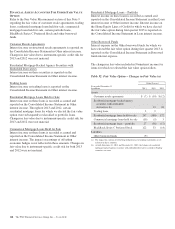PNC Bank 2013 Annual Report Download - page 177
Download and view the complete annual report
Please find page 177 of the 2013 PNC Bank annual report below. You can navigate through the pages in the report by either clicking on the pages listed below, or by using the keyword search tool below to find specific information within the annual report.L
OANS
Loans accounted for at fair value consist primarily of
residential mortgage loans. These loans are generally valued
similarly to residential mortgage loans held for sale and are
classified as Level 2. However, similar to residential mortgage
loans held for sale, if these loans are repurchased and
unsalable, they are classified as Level 3. In addition,
repurchased VA loans, where only a portion of the principal
will be reimbursed, are classified as Level 3. The fair value is
determined using a discounted cash flow calculation based on
our historical loss rate. Due to the unobservable nature of this
pool level approach, these loans are classified as Level 3.
Significant increases (decreases) in these assumptions would
result in a significantly lower (higher) fair value measurement.
During the first quarter of 2013, we elected to account for
certain home equity lines of credit at fair value. These loans
are classified as Level 3. This category also includes
repurchased brokered home equity loans. These loans are
repurchased due to a breach of representations or warranties in
the loan sales agreements and occur typically after the loan is
in default. Similar to existing loans classified as Level 3 due
to being repurchased and unsalable, the fair value price is
based on bids and market observations of transactions of
similar vintage. Because transaction details regarding the
credit and underwriting quality are often unavailable,
unobservable bid information from brokers and investors is
heavily relied upon. Accordingly, based on the significance of
unobservable inputs, these loans are classified as Level 3. The
fair value of these loans is included in the Loans – Home
equity line item in Table 89 in this Note 9.
Significant inputs to the valuation of residential mortgage
loans include credit and liquidity discount, cumulative default
rate, loss severity and gross discount rate and are deemed
representative of current market conditions. Significant
increases (decreases) in an assumption would result in a
significantly lower (higher) fair value measurement.
B
LACK
R
OCK
S
ERIES
CP
REFERRED
S
TOCK
We have elected to account for the shares of BlackRock Series
C Preferred Stock received in a stock exchange with
BlackRock at fair value. On January 31, 2013, we transferred
205,350 shares to BlackRock pursuant to our obligation to
partially fund a portion of certain BlackRock LTIP programs.
After this transfer, we hold approximately 1.3 million shares
of BlackRock Series C Preferred Stock, which are available to
fund our obligation in connection with the BlackRock LTIP
programs. The Series C Preferred Stock economically hedges
the BlackRock LTIP liability that is accounted for as a
derivative. The fair value of the Series C Preferred Stock is
determined using a third-party modeling approach, which
includes both observable and unobservable inputs. This
approach considers expectations of a default/liquidation event
and the use of liquidity discounts based on our inability to sell
the security at a fair, open market price in a timely manner.
Although dividends are equal to common shares and other
preferred series, significant transfer restrictions exist on our
Series C shares for any purpose other than to satisfy the LTIP
obligation. Due to the significance of unobservable inputs, this
security is classified as Level 3. Significant increases
(decreases) in the liquidity discount would result in a
significantly lower (higher) asset value for the BlackRock
Series C and vice versa for the BlackRock LTIP liability.
O
THER
A
SSETS AND
L
IABILITIES
We have entered into a prepaid forward contract with a
financial institution to mitigate the risk on a portion of PNC’s
deferred compensation, supplemental incentive savings plan
liabilities and certain stock based compensation awards that
are based on PNC’s stock price and are subject to market risk.
The prepaid forward contract is initially valued at the
transaction price and is subsequently valued by reference to
the market price of PNC’s stock and is recorded in either
Other Assets or Other Liabilities at fair value and is classified
in Level 2. In addition, deferred compensation and
supplemental incentive savings plan participants may also
invest based on fixed income and equity-based funds. PNC
utilizes a Rabbi Trust to hedge the returns by purchasing
similar funds on which the participant returns are based. The
Rabbi Trust balances are recorded in Other Assets at fair value
using the quoted market price. These assets are primarily
being classified in Levels 1 and 2. The other asset category
also includes FHLB interests and the retained interests related
to the Small Business Administration (SBA) securitizations
which are classified as Level 3. All Level 3 other assets are
included in the Insignificant Level 3 assets, net of liabilities
line item in Table 89 in this Note 9.
O
THER
B
ORROWED
F
UNDS
During the first quarter of 2013, we elected to account for
certain other borrowed funds consisting primarily of secured
debt at fair value. These other borrowed funds are classified as
Level 3. Significant unobservable inputs for these borrowed
funds include credit and liquidity discount and spread over the
benchmark curve. Significant increases (decreases) in these
assumptions would result in significantly lower (higher) fair
value measurement.
The PNC Financial Services Group, Inc. – Form 10-K 159


